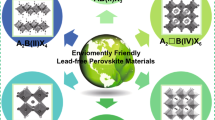Abstract
Lead halide perovskite solar cells (LHPSC) have great potential, with conversion efficiency exceeding 20%. However, their toxic nature and difficult fabrication prevent their consideration for commercial applications. To address this, numerical analysis was performed to propose a structure for lead-free perovskite solar cells with MASnI3 as absorber layer. Device modeling for Cd1−xZnxS as electron transport layer (ETL) and methylamine tin halide as hole transport layer (HTL) was carried out using a solar cell capacitance simulator. The simulation results revealed the dependence of the open-circuit voltage (VOC), short-circuit current (JSC), fill factor (FF), and power conversion efficiency on the HTL valence-band offset, absorber layer thickness, absorber layer doping concentration, ETL band offset, minority-carrier diffusion length, and defects at the HTL–absorber and absorber–ETL interfaces. An optimum absorber layer thickness was confirmed, being well consistent with the range for practical absorber layer designs. Moreover, conversion efficiency of 18.71% was found for absorber thickness of 500 nm and doping concentration of 1 × 1016 cm−3. These results will provide important guidelines for design of low-cost perovskite solar cells.
Similar content being viewed by others
References
S. De Wolf, J. Holovsky, S.J. Moon, P. Löper, B. Niesen, M. Ledinsky, F.J. Haug, J.H. Yum, and C. Ballif, J. Phys. Chem. Lett. (2014). https://doi.org/10.1021/jz500279b.
C. Quarti, E. Mosconi, J.M. Ball, V. D’Innocenzo, C. Tao, S. Pathak, H.J. Snaith, A. Petrozza, and F. De Angelis, Energy Environ. Sci. (2016). https://doi.org/10.1039/C5EE02925B.
Q. Dong, Y. Fang, Y. Shao, P. Mulligan, J. Qiu, L. Cao, and J. Huang, Sci. Express (2015). https://doi.org/10.1126/science.aaa5760.
W. Liao, D. Zhao, Y. Yu, N. Shrestha, K. Ghimire, C.R. Grice, C. Wang, Y. Xiao, A.J. Cimaroli, R.J. Ellingson, N.J. Podraza, K. Zhu, R.G. Xiong, and Y. Yan, J. Am. Chem. Soc. (2016). https://doi.org/10.1021/jacs.6b08337.
A. Kojima, K. Teshima, Y. Shirai, and T. Miyasaka, J. Am. Chem. Soc. (2009). https://doi.org/10.1021/ja809598r.
J.-H. Im, C.-R. Lee, J.-W. Lee, S.-W. Park, and N.-G. Park, Nanoscale (2011). https://doi.org/10.1039/c1nr10867k.
H.S. Kim, C.R. Lee, J.H. Im, K.B. Lee, T. Moehl, A. Marchioro, S.J. Moon, R. Humphry-Baker, J.H. Yum, J.E. Moser, M. Grätzel, and N.G. Park, Sci. Rep. (2012). https://doi.org/10.1038/srep00591.
J. Burschka, N. Pellet, S.J. Moon, R. Humphry-Baker, P. Gao, M.K. Nazeeruddin, and M. Grätzel, Nature (2013). https://doi.org/10.1038/nature12340.
M. Liu, M.B. Johnston, and H.J. Snaith, Nature (2013). https://doi.org/10.1038/nature12509.
M.A. Green, K. Emery, Y. Hishikawa, W. Warta, E.D. Dunlop, D.H. Levi, and A.W.Y. Ho-Baillie, Prog. Photovolt. Res. Appl. (2016). https://doi.org/10.1002/pip.2855.
Y. Yu, D. Zhao, C.R. Grice, W. Meng, C. Wang, W. Liao, A.J. Cimaroli, H. Zhang, K. Zhu, and Y. Yan, RSC Adv. (2016). https://doi.org/10.1039/C6RA19476A.
T. Fujihara, S. Terakawa, T. Matsushima, C. Qin, M. Yahiro, and C. Adachi, J. Mater. Chem. C (2017). https://doi.org/10.1039/C6TC05069G.
T.M. Koh, T. Krishnamoorthy, N. Yantara, C. Shi, W.L. Leong, P.P. Boix, A.C. Grimsdale, S.G. Mhaisalkar, and N. Mathews, J. Mater. Chem. A (2015). https://doi.org/10.1039/C5TA00190K.
Z. Zhao, F. Gu, Y. Li, W. Sun, S. Ye, H. Rao, Z. Liu, Z. Bian, and C. Huang, Adv. Sci. (2017). https://doi.org/10.1002/advs.201700204.
F. Hao, C.C. Stoumpos, D.H. Cao, R.P.H. Chang, and M.G. Kanatzidis, Nat. Photonics (2014). https://doi.org/10.1038/nphoton.2014.82.
J.S.J. Song, S.S. Li, S. Yoon, W.K. Kim, J.K.J. Kim, J. Chen, V. Craciun, T.J. Anderson, O.D. Crisalle, and F.R.F. Ren, Growth and characterization of CdZnS thin film buffer layers by chemical bath deposition, in Conference Record of the Thirty-First IEEE Photovoltaics Specialists, Conference 2005 (2005). https://doi.org/10.1109/pvsc.2005.1488166.
S. Ullah, H. Ullah, M. Mollar, and B. Mari, Fabrication of Cd1−xZnxS buffer layer deposited by chemical bath deposition for photovoltaic applications, in 2016 International Renewable Sustainable Energy Conference. IEEE (2016). https://doi.org/10.1109/irsec.2016.7983932.
L.L. Baranowski, S. Christensen, A.W. Welch, S. Lany, M. Young, E.S. Toberer, and A. Zakutayev, Mater. Chem. Front. (2017). https://doi.org/10.1039/C6QM00291A.
K.T.R. Reddy and P.J. Reddy, J. Phys. D Appl. Phys. (1992). https://doi.org/10.1088/0022-3727/25/9/011.
M. Burgelman, P. Nollet, and S. Degrave, Thin Solid Films (2000). https://doi.org/10.1016/S0040-6090(99)00825-1.
K.R. Adhikari, S. Gurung, B.K. Bhattarai, and B.M. Soucase, Phys. Status Solidi Curr. Top. Solid State Phys. (2016). https://doi.org/10.1002/pssc.201510078.
T. Minemoto and M. Murata, J. Appl. Phys. (2014). https://doi.org/10.1063/1.4891982.
Y.H. Khattak, F. Baig, S. Ullah, B. Marí, S. Beg, and H. Ullah, J. Renew. Sustain. Energy (2018). https://doi.org/10.1063/1.5023478.
Y.H. Khattak, F. Baig, T. Hanae, S. Ullah, B. Marí, S. Beg, and H. Ullah, Curr. Appl. Phys. (2018). https://doi.org/10.1016/j.cap.2018.03.013.
Y.H. Khattak, F. Baig, S. Ullah, B. Marí, S. Beg, and H. Ullah, Optik (Stuttg) (2018). https://doi.org/10.1016/j.ijleo.2018.03.055.
H.-J. Du, W.-C. Wang, and J.-Z. Zhu, Chin. Phys. B (2016). https://doi.org/10.1088/1674-1056/25/10/108802.
T. Minemoto and M. Murata, Sol. Energy Mater. Sol. Cells (2015). https://doi.org/10.1016/j.solmat.2014.10.036.
U. Rau and H.W. Schock, Appl. Phys. A Mater. Sci. Process. (1999). https://doi.org/10.1007/s003390050984.
M. Turcu and U. Rau, J. Phys. Chem. Solids (2003). https://doi.org/10.1016/S0022-3697(03)00137-9.
K. Tanaka, T. Minemoto, and H. Takakura, Sol. Energy (2009). https://doi.org/10.1016/j.solener.2008.09.003.
Author information
Authors and Affiliations
Corresponding author
Rights and permissions
About this article
Cite this article
Baig, F., Khattak, Y.H., Marí, B. et al. Efficiency Enhancement of CH3NH3SnI3 Solar Cells by Device Modeling. J. Electron. Mater. 47, 5275–5282 (2018). https://doi.org/10.1007/s11664-018-6406-3
Received:
Accepted:
Published:
Issue Date:
DOI: https://doi.org/10.1007/s11664-018-6406-3




